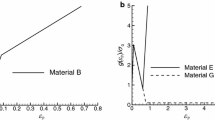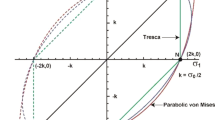Abstract
The problem of a plane strain crack lying along an interface between a rigid substrate and an elastic-plastic material has been studied. The elastic-plastic material exhibits pressure-sensitive yielding and plastic volumetric deformation. Two-term expansions of the asymptotic solutions for both closed frictionless and open crack-tip models have been obtained. The Mises effective stress in the interfacial crack-tip fields is a decreasing function of the pressure-sensitivity in both open and closed-crack tip models. The variable-separable solution exists for most pressure-sensitive materials and the limit values for existence of the variable-separable solution vary with the strain-hardening exponents. The governing equations become singular as the pressure-sensitivity limit is approached. Strength of the leading stress singularity is equal 1/(n+1) for both crack-tip models, regardless of the pressure-sensitivity. The second-order fields have been solved as an additional eigenvalue problem and the elasticity terms do not enter the second-order solutions as n≥2. The second exponents for the closed crack model are negative for the weak strain hardening, whereas the negative second-order eigenvalue in the open crack model slightly grows with the pressure-sensitivity. The second-order solutions are of significance in characterising the crack-tip fields. The leading-order solution contains the dominant mode I components for both open and closed crack-tip models when the materials do not have substantial strain hardening. The second-order solutions are generally mode-mixed and depend significantly on the pressure-sensitivity.
Similar content being viewed by others
References
J.R. Rice and G.C. Sih, Transaction of the ASME, Journal of Applied Mechanics 32 (1965) 418–423.
M.L. Williams, Bulletin of Seismological Society of America 49 (1959) 199–204.
C.F. Shih and R.J. Asaro, Transaction of the ASME, Journal of Applied Mechanics 56 (1989) 763–779.
C.F. Shih, Materials Science and Engineering A 143 (1991) 77–90.
M. Comninou, Transaction of the ASME, Journal of Applied Mechanics 44 (1977) 631–636.
N. Aravas and S.M. Sharma, Journal of the Mechanics and Physics of Solids 39 (1991) 311–344.
J.R. Rice, Transaction of the ASME, Journal of Applied Mechanics 55 (1988) 98–103.
S.M. Sharma and N. Aravas, Journal of the Mechanics and Physics of Solids 39 (1991) 1043–1072.
S.M. Sharma and N. Aravas, International Journal of Solids and Structures 30 (1993) 695–723.
E. Zywicz and D.M. Parks, Journal of the Mechanics and Physics of Solids 40 (1991) 511–536.
H. Yuan, Acta Mechanica (1991) in press.
K. Bose and P. Ponte Castañeda, Journal of the Mechanics and Physics of Solids 40 (1992) 1063–1103.
H. Yuan A. and Cornec, in Mis-Matching of Welds, ESIS 17K.-H. Schwalbe and M. Kocak (eds.), Mechanical Engineering Publications, London (1994) 141–159.
W.A. Spitzig and O. Richmond, Polymer Engineering Science 19 (1979) 1129–1139.
I.-W. Chen and P.E. Reyes Morel, Journal of American Ceramics Society 69 (1986) 181–189.
H.-J. Sue and A.F. Yee, Journal of Materials Science 24 (1989) 1447–1457.
H. Yuan and G. Lin, International Journal of Fracture 61 (1993) 295–330.
H. Yuan, G. Lin, A. Cornec and K.-H. Schwalbe, ‘On two-parameter characterization of crack tip fields in pressure-sensitive dilatant materials’ (1992) submitted for publication.
P. Ponte Castañeda and P.A. Mataga, International Journal of Solids and Structures 27 (1991) 105–133.
H. Yuan, ‘Singular stress fields at V-notch tips in elastoplastic pressure-sensitive materials’ (1993) submitted for publication.
N.P. O'Dowd C.F. and Shih, Journal of the Mechanics and Physics of Solids 39 (1991) 989–1015.
D.C. Drucker W. and Prager, Quarter of Applied Mathematics 10 (1952) 157–165.
F.Z. Li and J. Pan, Transaction of the ASME, Journal of Applied Mechanics 57 (1990) 40–49.
P. Deuflhard and G. Bader, ‘Multiple shooting techniques revised’, Technical Report 163, University of Heidelberg, SFB 123 (1982).
J.W. Rudnicki and J.R. Rice, Journal of the Mechanics and Physics of Solids 23 (1975) 371–394.
J.R. Rice, in Theoretical and Applied Mechanics, W.T. Koiter (ed.), North-Holland Publishing Co. (1977) 207–220.
J.W. Hutchinson, Journal of the Mechanics and Physics of Solids 16 (1968) 13–31.
J.R. Rice, Transaction of the ASME, Journal of Applied Mechanics 35 (1968) 379–386.
C.F. Shih, Fracture Analysis, ASTM STP 560, Philadelphia (1974) 187–210.
Z.E.A. Ben-Aoun and J. Pan, Engineering Fracture Mechanics 44 (1993) 649–662.
Author information
Authors and Affiliations
Rights and permissions
About this article
Cite this article
Yuan, H. Elastoplastic crack analysis for pressure-sensitive dilatant materials-Part II: Interface cracks. Int J Fract 69, 167–187 (1994). https://doi.org/10.1007/BF00035028
Received:
Accepted:
Issue Date:
DOI: https://doi.org/10.1007/BF00035028




